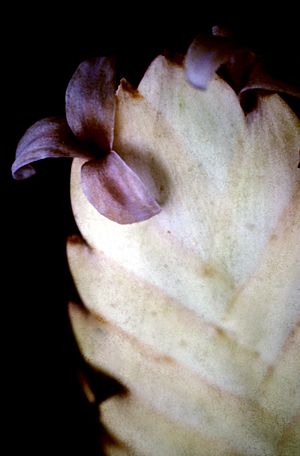Wallisia anceps facts for kids
Quick facts for kids Wallisia anceps |
|
|---|---|
 |
|
| Scientific classification | |
| Genus: |
Wallisia
|
| Species: |
anceps
|
| Synonyms | |
|
|
Wallisia anceps is a special kind of flowering plant that belongs to the genus Wallisia. It's often called an epiphyte, which means it grows on other plants like trees. But it doesn't hurt the tree! It just uses the tree for support, getting its water and nutrients from the air and rain.
This amazing plant is found in many warm places. It grows naturally in Central America, Colombia, Ecuador, and the islands of Trinidad and Tobago. You can also find it in the Guianas, Venezuela, and the northern parts of Brazil.
Contents
What is Wallisia anceps?
Wallisia anceps is a type of bromeliad. Bromeliads are a family of plants known for their unique shapes and often colorful flowers. Many bromeliads, like this one, are epiphytes. They are also sometimes called "air plants" because they don't need soil to grow.
How Does it Look?
This plant has long, narrow leaves that form a rosette. A rosette is like a circular arrangement of leaves, similar to how a rose's petals are arranged. The leaves are usually green and can be quite stiff.
The Beautiful Flowers
The flowers of Wallisia anceps are very interesting. They grow on a tall stalk that comes out from the center of the plant. The flowers themselves are often purple or pink, and they can be quite striking. They are usually surrounded by colorful bracts, which are like modified leaves that protect the flowers. These bracts can be bright pink or red, making the plant very noticeable.
Where Does it Live?
Wallisia anceps loves warm, humid places. It often grows in tropical rainforests. It attaches itself to tree branches or even rocks. It gets all the water it needs from the rain and moisture in the air. Its leaves are designed to collect water and nutrients.
Adapting to its Home
Because it doesn't grow in soil, Wallisia anceps has special ways to get food. Its leaves have tiny scales called trichomes. These trichomes help the plant absorb water and nutrients directly from the air. This is how it survives high up in the trees!
Life Cycle and Reproduction
Like all flowering plants, Wallisia anceps goes through a life cycle. It starts as a seed, grows into a mature plant, flowers, and then produces new seeds.
How Does it Reproduce?
Wallisia anceps can reproduce in a few ways. It produces seeds after its flowers are pollinated. These seeds can then be carried by wind or animals to new locations.
Producing Pups
Another cool way this plant reproduces is by making "pups." These are small baby plants that grow from the base of the parent plant. Once the pups are big enough, they can be separated and grow into new, independent plants. This is a common way for bromeliads to spread.
Caring for Wallisia anceps
Many people enjoy growing Wallisia anceps as a houseplant. They are relatively easy to care for once you understand their needs.
What Does it Need?
- Light: It likes bright, indirect light. Too much direct sun can burn its leaves.
- Water: Since it's an air plant, you don't water it like a regular potted plant. You can mist it with water a few times a week. You can also soak the whole plant in water for about 20-30 minutes once a week.
- Air Circulation: Good air flow is important to prevent rot.
- Temperature: It prefers warm temperatures, similar to its natural habitat.
Growing Tips
When growing Wallisia anceps at home, you can mount it on a piece of wood or cork bark. You can also place it in a terrarium or a decorative container without soil. Just make sure it gets enough light and moisture!
See also
 In Spanish: Tillandsia anceps para niños
In Spanish: Tillandsia anceps para niños

